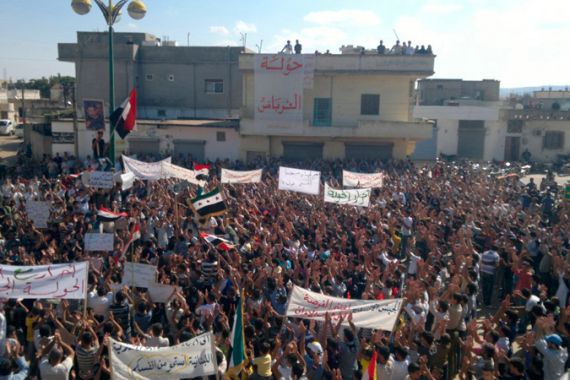No end to the revolution?
History has the answer for the turbulent Middle East of today.

The approaching centenary of the outbreak of World War I is a suitable time to consider violent conflicts between nations and ideologies, and their consequences, which have transformed the international system, particularly in the Middle East.
The most decisive of these conflicts were part of three critical periods of the 20th century: World War I, 1914-1918, and the 1917 communist revolution in Russia; World War II ending in 1945 with the division of Europe and the Cold War thereafter; and the Soviet Union’s collapse in 1991. These fateful chapters of history left a lasting impact on the global map, and transformed the Middle East into the turbulent region which it is today.
Despite the central powers’ defeat in World War I, Germany and Austria-Hungary lived to fight another war two decades later. But the most consequential events of the World War I period were the fall of the Ottoman Empire, and the rise of communists to power in Russia.
Creation of mandates
The demise of the Ottoman Empire meant the release of its provinces in the Middle East. The region was divided into British and French spheres of influence, using the instrument of “mandate” and readily approved by the League of Nations. The Russian Revolution of 1917 led to the birth of the Soviet Union five years after. Communism became an ideological reality that promised liberation forces in colonies as an alternative to imperial subjugation.
The age of empires was not over, but there was a new worldview in action, embracing the idea of class struggle and becoming a serious rival of Western imperialism. The events in Russia in 1917, emboldened revolutionary forces across Asia, Africa and South America. Communists seized power after long, savage wars in China in 1949, and Cuba in 1959. Mao Zedong, Fidel Castro and Ernesto Che Guevara became heroes for left-wing armed revolutionaries in their own countries and elsewhere.
|
The peoples of the Middle East have lived through autocratic nationalist rule, and dictatorship acting as proxy of one external power or another. Their painful experiences have made the Middle East of today. |
The Soviet Union’s emergence as a superpower rival of the United States in the wake of World War II, gave it a formidable status, and the means to support revolutionary movements across the world. However, there was an obvious paradox in the manner of the Soviet occupation of Eastern Europe, and how the Kremlin controlled its satellite-states with an iron fist for more than four decades.
The Soviet Union had enlarged its empire from Central Asia to Eastern Europe while proclaiming to be the liberator of oppressed peoples from Western imperialism. The Soviets were also involved with the US in a global race for influence called the Cold War, in which the energy-rich Middle East was the main battleground. Even as the colonial system collapsed, the Cold War intensified. It was a race between two empires in all but name.
The Dictionary of Human Geography defines imperialism as “an unequal human and territorial relationship”. The association takes the form of an empire, based on “ideas of superiority and practices of dominance”. Imperialism involves the extension of authority and control of one state or people over another. While capitalism has solely commercial motives, an imperial relationship also requires a political centre and ideological allegiance which ties the periphery to the centre.
Legacy of Cold War
Rival ideologies pulled Middle Eastern countries towards Washington and Moscow during the Cold War, and fuelled conflicts that had remained unsettled. The Soviet Union’s collapse in 1991 was to have been the end of history, with the US the final victor standing, to dominate the vast energy resources, and much more. However, that triumphant vision failed to realise that Islam, together with nationalism, was going to be the next formidable opposition, replacing Soviet communism. A lot of blood has been spilled at the extremes of that conflict, while even moderates are critical or ambivalent about Western policy.
Much of the Middle East is in a state of agitation and turmoil. The legacy of old unresolved feuds has been revived. Two of the main causes are the imperial powers’ arbitrary partition of the region into smaller, vulnerable entities, thereby dividing their peoples; and the Palestinians’ loss of land and livelihood under Israeli occupation. The people’s desire to liberate themselves from dictatorship has been rekindled, but the scope for opportunistic machinations from outside remains.
Islamic, secular and democratic, all forces fight, sometimes together, at other times separately, in this chaotic struggle. Their vision of the future may differ, but their spirit is revolutionary in that they seek radical change. Still, fundamental questions about what type of change, and the way to bring it, remain. Hope, fear, and uncertainty, coalesce together.
The risk of tyranny of some over many is always great in a region of diverse religious and ethnic groups, with a history of conflict. From Afghanistan and Iraq to Syria, Egypt and Libya, violence against vulnerable citizens, minorities in particular, heightens fears in those countries and outside.
The peoples of the Middle East have lived through autocratic nationalist rule, and dictatorship acting as proxy of one external power or another. Their painful experiences have made the Middle East of today. Where are events heading? Well, as French thinker Alexis de Tocqueville said, “In a revolution, as in a novel, the most difficult part to invent is the end.”
Deepak Tripathi, fellow of the Royal Historical Society and the Royal Asiatic Society of Great Britain and Ireland, is a British historian of the Middle East, the Cold War and America in the post-Soviet world.
